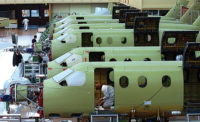For more than 70 years, Toyoda Iron Works Co. Ltd. (TIW) has supplied steel-plate body frame components, chassis elements and other auto parts to numerous automakers worldwide. TIW is headquartered in Toyota City and manufactures parts in three plants in Japan and 10 plants overseas. Seventy-five percent of its production is for Toyota Motor Corp. (TMC).
Nearly 20 years ago, TIW part designers transitioned from 2D to 3D CAD software. Several years later, certain departments within the company began using 3D CAD and computer-aided engineering (CAE) software. Unfortunately, the lack of companywide standards often led to unnecessary rework in the late stages of design and production planning by engineers in those departments.
Around the same time, TMC launched a “3D as the Master” initiative, which included providing 3D data to suppliers like TIW. It, in turn, launched an internal Digital and Simultaneous Engineering Initiative.
This initiative is designed to make TIW a 3D model-based enterprise and help the company eliminate design rework, reduce related costs by 80 percent and reduce the overall lead time from development to production readiness. It also eliminates the need for one department to convert 3D CAD data to a 2D TIFF format to share it with another department.
After some research, company management chose XVL 3D modeling software from Lattice Technology Inc. to meet all of these goals. XVL lets any department immediately retrieve 3D data from the plant data management system and use it to improve any business process. TIW is also able to easily share XVL data with its trusted suppliers for more efficient communication.
Managers at TIW especially like that XVL retains CAD-level accuracy in all data, is CAD agnostic and lets engineers import models in different CAD formats into a single file—including models as large as a gigabyte in size. This consolidated file can then be managed by XVL Contents Manager in downstream functions.
The Quality Control (QC) department at TIW is benefitting from XVL as well by using it to create precise measurement instructions. QC specialists cross-reference the detailed XVL model at the points to be measured and paste each point into an Excel worksheet.
TIW also uses XVL to validate welding procedures, check for interferences and optimize welding gun usage. This has reduced the time it takes to produce welding plans.
Finally, the supplier uses the software for packaging analysis, which involves testing many arrangements of multiple copies of parts and assemblies. A worker converts part and pallet data to an XVL file before opening part and pallet models in XVL Studio. He then uses the software’s part-copy and move functions to perform a layout analysis.
The results are so accurate that workers no longer need to validate packaging with physical prototypes. This has resulted in substantial time, labor and transportation savings, including a 30 percent cost reduction to create dedicated pallets.
An unforeseen benefit of the XVL software is improved client communications. Often times, the data TIW receives from clients is incomplete. Assembly information may be missing, for example, or the data lacks critical properties such as board thickness and material. With XVL, TIW engineers are now able to add the required properties so assemblers can accurately build products as a post-processing task. The software also validates assembly processes.
Because of XVL’s numerous benefits, TIW uses 3D modeling for all of its main products, even though some suppliers and overseas factories still use 2D drawings. TIW’s future plans include using XVL for worker training, to create common work instructions and to produce 3D documentation for additional stakeholders.
The company is also hopeful that making 3D documentation available on mobile devices like iPads will get holdout suppliers and clients to replace their 2D drawings with 3D ones. For more information on 3D modeling software, call 415-274-1670 or visit www.lattice3d.com.







